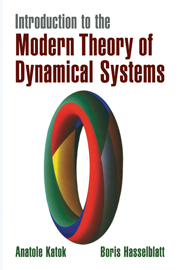Book contents
- Frontmatter
- Contents
- PREFACE
- 0 INTRODUCTION
- Part 1 Examples and fundamental concepts
- Part 2 Local analysis and orbit growth
- 6 LOCAL HYPERBOLIC THEORY AND ITS APPLICATIONS
- 7 TRANSVERSALITY AND GENERICITY
- 8 ORBIT GROWTH ARISING FROM TOPOLOGY
- 9 VARIATIONAL ASPECTS OF DYNAMICS
- Part 3 Low-dimensional phenomena
- Part 4 Hyperbolic dynamical systems
- Appendix: BACKGROUND MATERIAL
- NOTES
- HINTS AND ANSWERS TO THE EXERCISES
- REFERENCES
- INDEX
7 - TRANSVERSALITY AND GENERICITY
Published online by Cambridge University Press: 05 June 2012
- Frontmatter
- Contents
- PREFACE
- 0 INTRODUCTION
- Part 1 Examples and fundamental concepts
- Part 2 Local analysis and orbit growth
- 6 LOCAL HYPERBOLIC THEORY AND ITS APPLICATIONS
- 7 TRANSVERSALITY AND GENERICITY
- 8 ORBIT GROWTH ARISING FROM TOPOLOGY
- 9 VARIATIONAL ASPECTS OF DYNAMICS
- Part 3 Low-dimensional phenomena
- Part 4 Hyperbolic dynamical systems
- Appendix: BACKGROUND MATERIAL
- NOTES
- HINTS AND ANSWERS TO THE EXERCISES
- REFERENCES
- INDEX
Summary
In this chapter we present several results concerning properties that are exhibited by “most” dynamical systems in various natural classes. This requires first looking into natural notions of “large” or “small” sets in infinite-dimensional spaces. Our main conclusion, the Kupka-Smale Theorem 7.2.6, shows that in a certain rather weak sense hyperbolic behavior is typical. In Section 7.3 we give a very brief glimpse of the important notion of bifurcation which represents an attempt to understand how typical behavior breaks down and how different types of typical behavior are transformed into each other.
Generic properties of dynamical systems
a. Residual sets and sets of first category. When we study how various invariants (properties) of dynamical systems change with changes in the system we naturally assume some topology in the space of systems under consideration and it is most desirable to have a property not change at all, at least locally, that is, when the original system is only perturbed slightly.
This is quite natural from the viewpoint of applications: If a mathematical model describes a physical system its parameters are usually only known with limited precision. If a particular property is observed for an open set of dynamical systems and hence an open set of parameters, then it is likely to reflect the true properties of the physical system.
Structural stability represents a good example of such a situation, at least from the topological point of view: Any topological property of a structurally stable system is unchanged under small perturbation.
- Type
- Chapter
- Information
- Introduction to the Modern Theory of Dynamical Systems , pp. 287 - 306Publisher: Cambridge University PressPrint publication year: 1995



